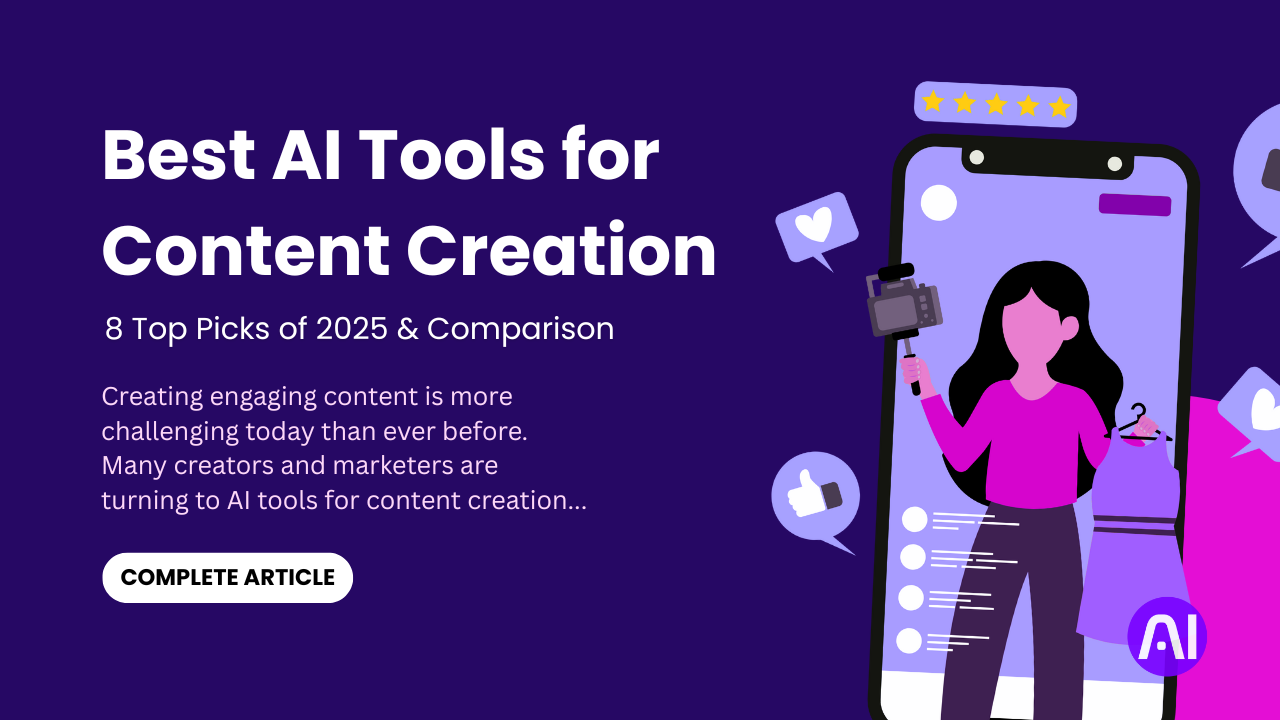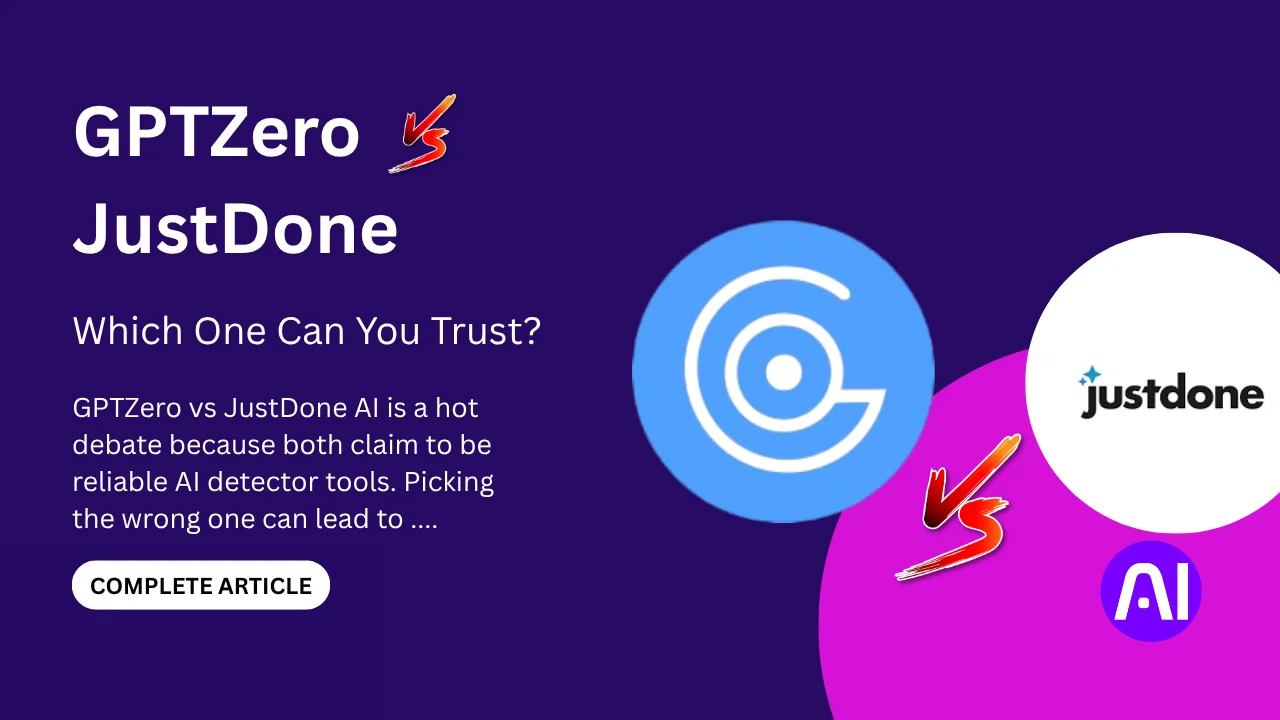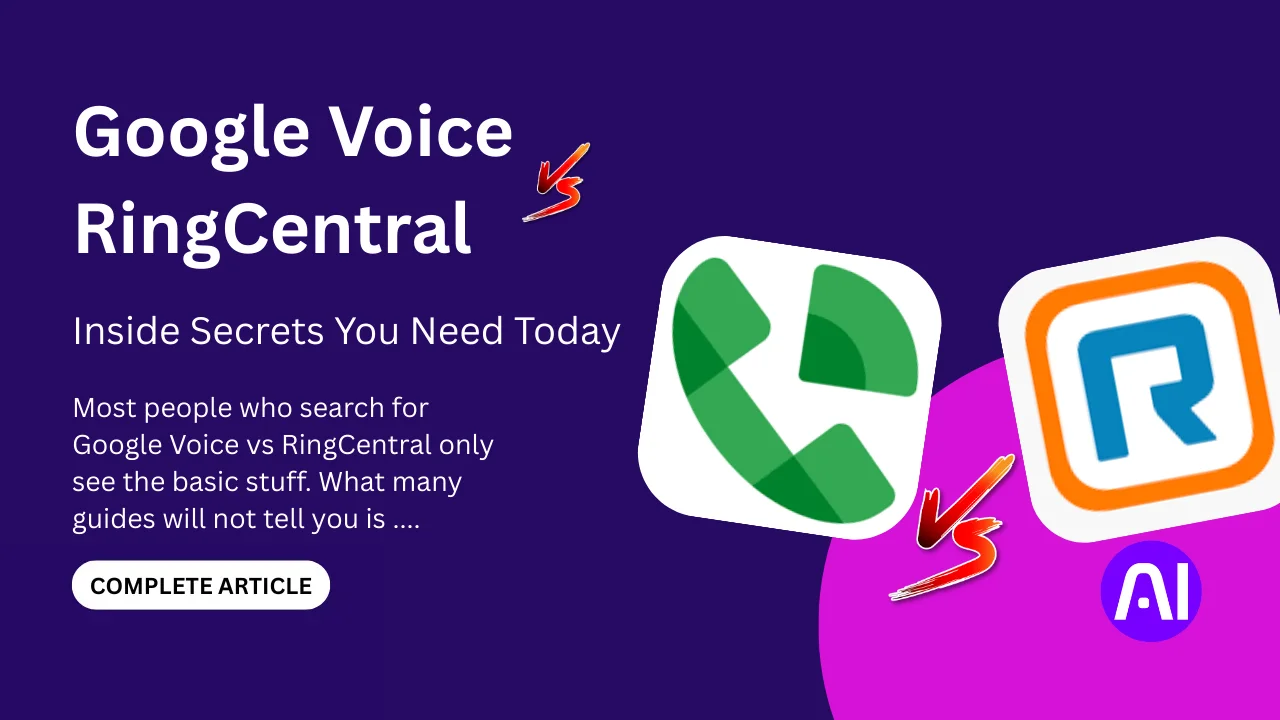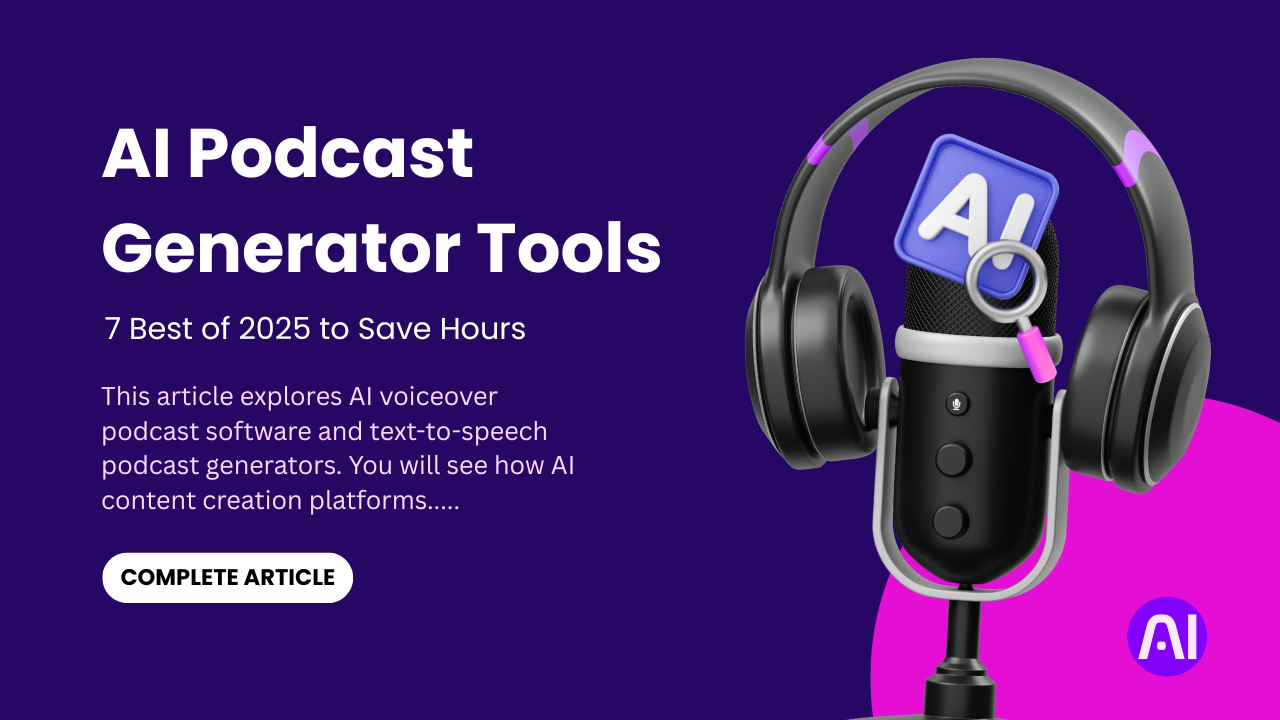Creating engaging content is more challenging today than ever before. Many creators and marketers are turning to AI tools for content creation. These tools simplify writing, design, video, and audio tasks with smart automation. You can save time, improve quality, and stay consistent across multiple platforms. That’s why exploring the best AI tools for content creation is so important.
What Are AI Tools for Content Creation?
AI tools for content creation are software powered by artificial intelligence. They assist with writing, designing, editing, and producing digital content more efficiently. By understanding user prompts, these tools generate relevant outputs instantly. Bloggers, marketers, designers, and businesses use them to save time and effort. In short, AI content creation tools boost productivity while reducing manual creative workload.
AI tools help create blogs, ads, videos, and designs quickly. They make writing, editing, and designing easier, saving time for businesses and creators.
Tools like Jasper, Copy.ai, and Rytr focus on writing, while Canva AI, Descript, and Pictory handle visuals and media. Predis.ai is great for social posts, though each tool has its own limits.
Main categories of Content Creation tools
AI tools for content creation serve different purposes depending on your needs. Some focus on writing blog posts or marketing copy quickly and clearly. Others are built for generating visuals, graphics, or social media content instantly. There are also tools for editing videos, creating voiceovers, or making animations. By grouping them into categories, it becomes easier to pick the right tool.
AI Writing Tools
AI writing tools are designed to generate text-based content, such as blogs and articles. They utilize machine learning to comprehend context and generate natural language outputs. Many of them also help with grammar, tone, and SEO optimization. A good AI writing tool saves time while maintaining consistent quality in writing. These tools are best suited for bloggers, marketers, and agencies that produce large volumes of content.
AI Image & Design Tools
AI image tools allow creators to generate visuals, banners, or designs effortlessly. They use prompts or templates to produce creative and unique graphics quickly. Marketers use them for social media, ads, and visual branding. With such tools, you don’t always need advanced design skills anymore. They simplify tasks while maintaining a professional look for visual content.
AI Video & Audio Tools
AI video and audio tools make multimedia content creation simple and efficient. They allow creators to edit videos, generate captions, and produce voiceovers. These tools also provide templates for quick video production with minimal effort. Podcasters, YouTubers, and educators benefit from these AI-driven features. Overall, they reduce editing time while improving the professional quality of multimedia content.
Social Media Content Tools
AI social media tools help manage content across platforms in smarter ways. They create captions, design visuals, and schedule posts for better reach. Some tools also analyze engagement to suggest the best posting times. With automation, creators spend less time worrying about small repetitive tasks. These tools ensure consistent posting and stronger audience engagement on social channels.
Top 8 AI Tools for Content Creation
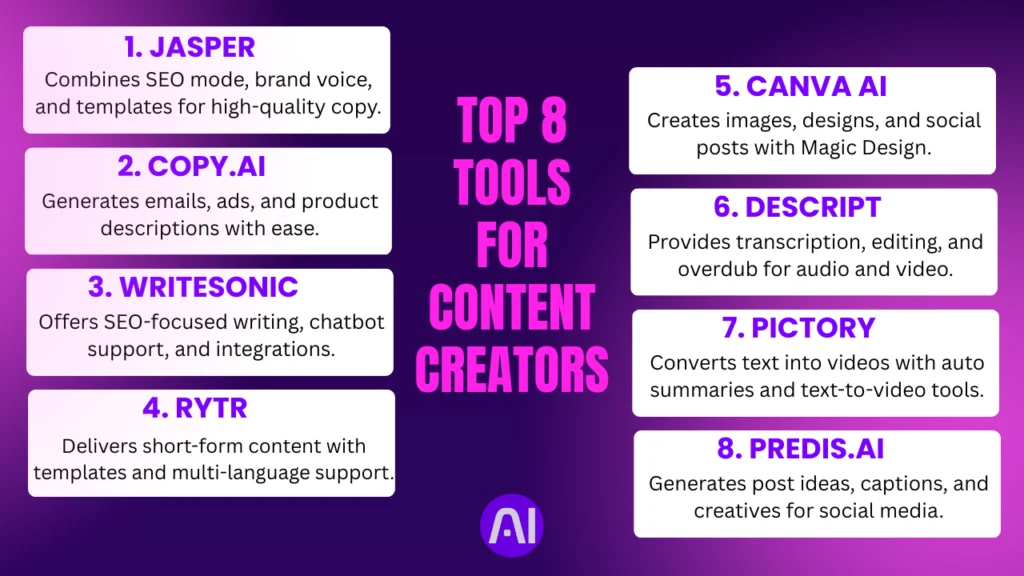
Many AI content tools are available, but only a few stand out. To help you decide, here’s a breakdown of the most popular ones. Each tool serves a unique purpose, making it easier to find the right fit. Some focus on writing, others on images, videos, or social media. Comparing their features and pricing gives a clear picture before investing money.
1. Jasper
Key features:
Brand Voice & Templates – Writes in your style with ready-made formats.
SEO & Collaboration – Optimizes content and supports teams.
Creativity & Enterprise – Offers AI images, no limits, and security.
Jasper is one of the most popular AI writing tools today. It helps marketers, agencies, and bloggers generate long-form content with ease. The tool features advanced SEO capabilities and customizable templates. Jasper also adapts tone and style, making it great for branded content.
Its main strength is high-quality output that requires minimal editing afterward. However, the pricing may feel high for beginners and freelancers. Teams find it especially useful for creating consistent content across different platforms. Overall, Jasper is a solid investment for professional-level content creators.
2. Copy.ai
Key features:
Brand Voice & Infobase – Keeps content consistent with your style.
Chat & Prompts – Generates blogs, ads, and emails fast.
Teamspaces & Workflows – Supports collaboration and automation.
Copy.ai specializes in creating short-form marketing content, such as ads and emails. It is especially useful for entrepreneurs and small businesses on a budget. The tool provides ready-made templates for quick copywriting solutions. Many users enjoy its free plan for testing before upgrading.
Copy.ai creates creative and catchy outputs that save time and effort. However, the content sometimes feels repetitive and needs refinement. Despite that, it remains popular because ofits affordability and accessibility. It’s a practical choice for anyone needing short, engaging marketing copy.
3. Writesonic
Key features:
SEO & Integrations – Creates blogs and ads with SEO support.
Versatile Tools – Offers 80+ writing features and templates.
Affordable Plans – Budget-friendly with free trial options.
Writesonic is a versatile AI platform made for blog and SEO writing. It supports long-form content, chatbots, and integrations with marketing platforms. This makes it ideal for digital marketers who want scalable content. Writesonic also offers an affordable entry-level plan compared to Jasper.
The tool generates solid, SEO-friendly drafts but may require some light editing. Its chatbot integration helps in customer service and conversational marketing. Small teams benefit from its balance of features and pricing. Writesonic offers flexibility for creators who need both quality and affordability.
4. Rytr
Key features:
Multi-Language Support – Writes in 30+ languages.
Templates & Tones – Quick short-form copy in various styles.
Budget Option – Simple, low-cost plans for starters.
Rytr is a budget-friendly AI writing tool that is popular among freelancers. It helps produce emails, captions, and short blog content quickly. The platform supports multiple languages, making it suitable for global users. Rytr also offers an easy-to-use interface with fast learning curves.
Although affordable, Rytr lacks the advanced SEO features of bigger tools. Users may find its long-form writing less polished compared to Jasper. Still, it delivers good value for beginners and low-budget creators. For quick tasks, Rytr is a smart and accessible option.
5. Canva AI
Key features:
Magic Studio – Generates images, video, and text designs.
Easy Templates – Drag-and-drop visuals for beginners.
Smart Editing – Tools for quick, AI-assisted design fixes.
Canva AI is a powerful tool for creating visual content easily. It offers templates, Magic Design, and drag-and-drop editing tools. Marketers use it to make social media graphics and promotional visuals. With its simplicity, Canva is beginner-friendly yet professional-looking.
The tool’s free version offers plenty, but the Pro version unlocks even better features. It is not as advanced as design-focused software like Photoshop. However, Canva balances accessibility and efficiency for fast content creation. For non-designers, it is one of the most practical AI tools.
6. Descript
Key features:
Text-Based Editing – Edit audio/video by editing text.
AI Voices – Includes cloning and overdub features.
Podcast Ready – Great for creators with transcription tools.
Descript is an AI-powered tool designed for audio and video editing. It allows creators to transcribe, cut, and edit files like text. The tool also provides overdubbing, making it useful for podcasters and trainers. Descript is ideal for creators needing fast, accurate multimedia editing.
One of its strongest features is automatic transcription with high accuracy. Beginners may face a slight learning curve when using advanced tools. Still, it replaces multiple software for recording, editing, and publishing. Overall, Descript saves time and streamlines the multimedia content workflow.
7. Pictory
Script to Video – Turns text or blogs into videos.
AI Voices & B-roll – Adds narration and stock clips.
Quick Editing – Simple, text-driven video adjustments.
Pictory is an AI tool that transforms text into engaging short videos. It’s great for summarizing articles, blogs, or scripts into video format. The tool provides ready-made templates for easy and quick video production. Many marketers use it for YouTube, ads, and social campaigns.
The platform’s biggest advantage is its speed in generating video content. However, it offers limited customization compared to professional editing software. Beginners appreciate its simplicity and automation for quick visual storytelling. For marketers needing regular videos, Pictory is an excellent time-saver.
8. Predis.ai
Key features:
Social Content – Auto-creates posts, captions, and creatives.
Ad & Video Tools – Designs ads and short video clips.
Scheduling Support – Helps plan and auto-publish posts.
Predis.ai focuses on creating social media content for businesses and creators. It generates captions, images, and post ideas using simple prompts. The tool also analyzes trends and suggests content that aligns with audience interests. Predis.ai is especially useful for small businesses building online presence.
The platform is easy to use, but it is limited to short-form posts. It doesn’t work well for long articles, blogs, or in-depth writing. Still, it helps users maintain a consistent social media schedule effectively. For lightweight content creation, Predis.ai is a practical AI tool.
Comparing the Best Options
AI tools for content creation come in many forms, each tailored for specific needs like writing, design, video, or social media. The table below highlights the best options, their features, pros, cons, and pricing.
| Tool | Best For | Key Features | Pros | Cons | Pricing / Plan Highlights |
|---|---|---|---|---|---|
| Jasper | Blog & copywriting | SEO mode, brand voice, templates | High-quality output, easy use | Pricey for beginners | Starts $39/month |
| Copy.ai | Marketing copy | Email, ads, product descriptions | Free plan available | Sometimes repetitive output | Free, Pro $49/month |
| Writesonic | SEO writing & blogs | AI writer, chatbot, integrations | Affordable plans, SEO-focused | Output requires editing | Free trial, from $16/month |
| Rytr | Short-form writing | Templates, multiple languages | Budget-friendly | Limited features vs Jasper | Free plan, $9/month |
| Canva AI | Image & design | Magic Design, templates, social posts | Easy for beginners | Less advanced than Photoshop | Free, Pro $14.99/month |
| Descript | Audio & video | Transcription, editing, overdub | Great for podcasts & videos | Learning curve for beginners | Free plan, from $12/month |
| Pictory | Video creation | Auto summarize, text-to-video | Quick video generation | Limited customization | Free trial, $19/month |
| Predis.ai | Social media content | Post ideas, captions, creatives | Perfect for small businesses | Not suitable for long content | Free, $29/month |
Choosing the right tool depends on your goals—whether it’s SEO blogs, social posts, or videos, these platforms make creating high-quality content faster and easier.
How to Choose the Right AI Tool
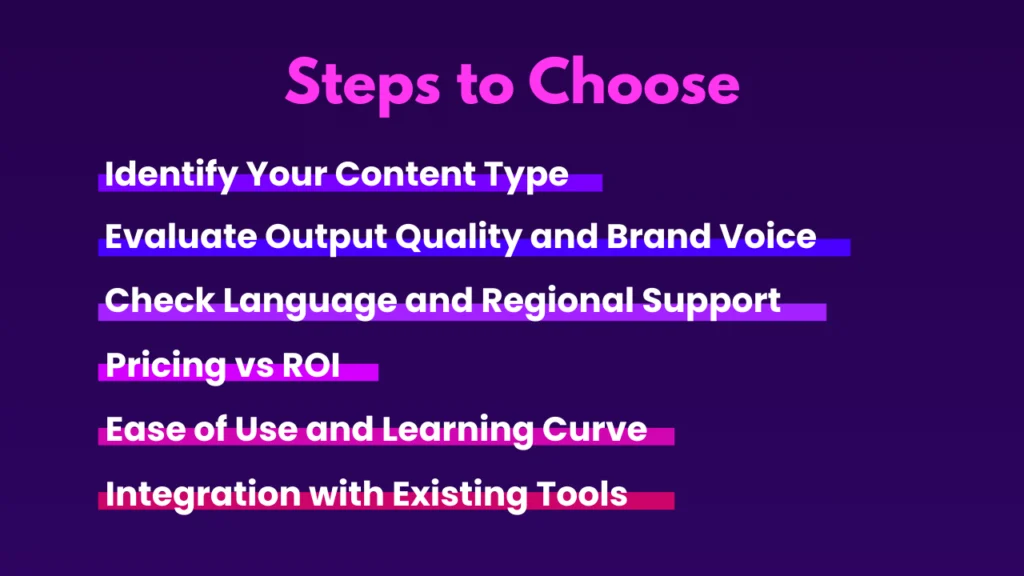
Choosing the best AI tool depends on your specific content needs. Every creator has different goals, whether it’s writing, video, or social posts. A good choice balances output quality, ease of use, and pricing. Considering these factors helps you invest in the right solution.
Identify Your Content Type
The first step is to determine the type of content you create. Writers, designers, and video creators all need different kinds of AI tools. For example, Jasper is better for writing while Pictory is best for videos. Matching tool strength with your goals saves time and avoids frustration.
Evaluate Output Quality and Brand Voice
Not all AI tools consistently produce the same level of quality. Some tools allow for customization to match your brand’s voice more effectively. It’s essential to test sample outputs before making a final commitment. A tool that mirrors your brand tone will strengthen long-term audience trust.
Check Language and Regional Support
Many creators need content in multiple languages for wider audience reach. AI tools with multilingual features enable quick connection with global customers. Some also offer regional content suggestions for specific markets and cultures. Choosing tools with such support ensures more personalized and inclusive communication.
Pricing vs ROI
Pricing is a crucial factor when selecting an AI tool wisely. Free versions are fine for beginners, but professionals need premium features. Consider how much content volume you plan to produce monthly. If ROI is higher than cost, investing in premium tools makes sense.
Ease of Use and Learning Curve
Complex tools can hinder creators despite offering advanced features. A user-friendly interface saves time and reduces frustration for new users. Tutorials, templates, and community support also make a big difference. Pick a tool that balances simplicity with strong functions for everyday tasks.
Integration with Existing Tools
Many businesses already utilize CMS platforms, scheduling tools, or design applications. AI tools that integrate smoothly with these save time and improve workflow. For example, Writesonic connects with WordPress and Canva syncs with social media. Such integrations reduce repetitive tasks and increase overall productivity greatly.
This is also suggested for you: Best Artificial Intelligence for Coding That Could Replace You
Common Pitfalls & Ethical Considerations
AI tools for content creation are powerful, but they have drawbacks. Over-reliance can reduce creativity and make content feel generic. Ethical issues like plagiarism, misinformation, and biased outputs also exist. Understanding these pitfalls helps creators use AI responsibly and effectively.
Over-Reliance on AI
Many creators depend too much on AI without adding personal input. This can result in repetitive or robotic content that lacks originality. Readers quickly lose interest when content feels generic or predictable. Always review and edit AI outputs to ensure unique, valuable creations.
Plagiarism and Copyright Concerns
AI tools sometimes generate content resembling existing online material closely. This raises risks of plagiarism or copyright infringement for creators and brands. Checking originality with plagiarism detectors is an important protective step. It’s safer to treat AI content as drafts, not final products.
AI Detection and Authenticity
Search engines and platforms are improving AI content detection systems. Overuse of unedited AI text may harm credibility or SEO performance. Blending AI drafts with human editing improves authenticity significantly. Authenticity helps build trust while still leveraging AI efficiency effectively.
Bias and Inaccuracy
AI tools depend on data, which may contain bias or errors. This can lead to inaccurate information or culturally insensitive suggestions. Fact-checking every generated piece is crucial for professional content creators. Ethical use requires balancing AI output with human oversight and knowledge.
Trends & What’s Coming in AI Content Creation
AI content creation is advancing quickly, bringing exciting new possibilities. Tools are becoming more powerful, offering features across multiple content types. From text and images to videos and voices, everything is improving fast. Knowing these trends helps creators prepare for the future of content.
Multi-Modal Tools
The future of AI lies in multimodal tools that combine multiple functions. These tools can generate text, images, audio, and video seamlessly together. For example, one platform may write scripts and create matching visuals. Multi-modal features save time and unify the entire creative process.
Local and Multilingual Support
AI tools are now improving in producing content for local markets. They can generate region-specific content tailored to cultural preferences better. Multilingual features help businesses connect with global audiences quickly and effectively. This makes AI highly valuable for companies with international customers.
Advanced Voice and Avatar Tools
Voice cloning and avatar creation are becoming increasingly realistic with AI. These tools let businesses create lifelike virtual presenters and narrators. They work well for e-learning, marketing videos, and interactive experiences. Such features enhance storytelling and expand creative possibilities significantly.
Personalization and Brand Voice Mapping
AI tools are learning to adapt closely to brand voice and style. They analyze past content to create more personalized outputs automatically. This ensures consistent tone across blogs, ads, and social platforms. Personalized AI outputs increase trust and strengthen connections with the audience.
Conclusion
AI tools for content creation are changing the way creators work today. They make writing, designing, and producing videos or audio faster and easier. With the right choice, businesses can save time and boost productivity. The key is balancing AI efficiency with human creativity and oversight.
If you’re a beginner, start with free plans to explore different options. Professionals should invest in paid tools for better features and reliability. Always review AI content for originality, accuracy, and brand voice consistency. Used wisely, AI tools for content creation become powerful partners in success.
If you want to explore other top lists of productive AI tools, you can explroe the category of “AI Tools” of our blog.
This writing is suggested for you; AI Podcast Generator Tools 2025 | Save Your Hours!!
FAQs
Is AI content good for SEO?
AI content can be good for SEO if optimized correctly. It helps generate keyword-rich drafts faster than manual writing methods. However, human editing ensures quality, originality, and accuracy remain intact. Combining AI with SEO expertise brings the best long-term search results.
Will AI replace human writers?
AI will not completely replace human writers anytime in the future. It supports writers by saving time and automating repetitive tasks. Human creativity, storytelling, and emotional depth cannot be fully replaced. The best approach is collaboration between AI tools and human creators.
How much do these tools cost typically?
The cost of AI tools varies based on features and plans. Many tools offer free trials or freemium models for beginners. Paid subscriptions usually range from $10 to $100 monthly. Enterprise plans can go higher depending on scale and advanced functions.
Can I trust the facts generated by AI?
AI content is not always 100% factually accurate or reliable. It often predicts patterns rather than confirming true information directly. Fact-checking with trusted sources is always necessary for professionals. AI should be treated as an assistant, not the final authority on facts.

